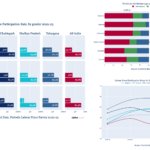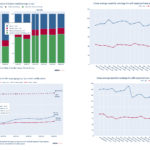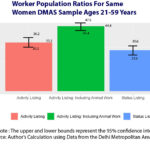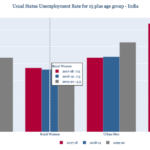Daily status, weekly status, usual status: Why labour force participation rates vary by reference period
Scholars who have ever used data from the Periodic Labour Force Surveys (PLFS) and the previous Employment-Unemployment Surveys of the NSS would be familiar that economic activity is captured and reported in different ways. The surveys identify respondents’ economic activities based on a “daily status”, the “current weekly status” and the “usual status”. Based on which timeframe one uses, one could arrive at slightly different values of labour force participation rates, unemployment, worker population ratio etc.
For instance, in 2022-23, India’s labour force participation rate for the working age population was 61.6 percent by usual (principal + subsidiary) status. By the current weekly status, it was 58.3 percent, and it was 54.1 percent by current daily status. Similarly for unemployment, the numbers varied from 2.1 percent (usual status) to 5.5 percent (daily status).
These differences stem from the way these indicators are measured in these surveys. The sections below explain each of these reference periods in more detail.
Broad grouping of the activity status
A person could be engaged in “work” in one or a combination of the following three broad activity statuses during a reference time period:
- working (being engaged in economic activity)
- not working (being not engaged in an economic activity) but either making tangible efforts to seek work or available for work if ‘work’ is available and
- not working and also not available for work.
Individuals need not necessarily fit in only one – they could be in all the three broad activity groups during a given time interval. Thus, the specific identification of the type of employment and/or sector of activity is done by adopting either the major time or priority criterion. The former is used for classification of persons according to the ‘usual activity status’ approach and the latter is used for classification of persons according to the ‘current activity status’ approach.
Each of the broad activity statuses is further sub-divided into several detailed activity categories. If a person categorised as engaged in economic activity by adopting one of the two criteria mentioned above is pursuing more than one economic activity during the reference period, the appropriate detailed activity status is that activity in which a relatively longer time is spent. A similar procedure is adopted for assigning detailed activity for persons categorized as engaged in non-economic activity and pursuing more than one non-economic activity.
Usual principal activity status
The usual activity status relates to the activity status of a person during the reference period of 365 days preceding the date of survey. This is identified in two stages. At the first stage, persons are categorised as those in the labour force (either employed or unemployed) and those not in the labour force using the major time spent criteria. Persons adjudged as not belonging to the labour force are assigned the broad activity status ‘neither working nor available for work’ (not in the labour force).
At the second stage, for persons belonging to the labour force, the broad activity status of either ‘working’ (employed) or ‘not working but seeking and/or available for work’ (unemployed) is ascertained based on the same criterion viz. relatively long time spent in accordance with either of the two broad statuses within the labour force.
The activity status on which a person spent major part of the time during the 365 days preceding the date of survey is considered as the usual principal activity status of the person. Within the broad activity status so determined, the detailed activity status of a person pursuing more than one such activity is determined once again on the basis of the relatively long time spent on such activities.
Usual subsidiary economic activity status
A person whose usual principal status is determined using the major time criterion could also have pursued some economic activity for a shorter time throughout the reference year which is not less than 30 days. This economic activity is recorded as the subsidiary economic activity status of that person.
The activity status, determined on the basis of either the usual principal economic activity or the usual subsidiary economic activity is called the usual activity status of the person implying a worker who performs some work activity either in the principal status or in the subsidiary status during the year.
The persons thus counted as usual workers provide the size of the workforce in the population, though strictly they may not correspond to the exact labour input to the economy. This measure is useful in the context of the prevailing informal sector with self-employed and owner-operated household enterprises and the predominance of agricultural activities that are mostly seasonal in nature.
The interpretation of the usually employed persons does not pose much problem. These are persons who are reported ‘usually’ employed or ‘usually’ unemployed for a major part of time during the year. The usually employed therefore is an indicator of the persons who have a stable attachment with some economic activity though they may not be pursuing the same at a specific point of time. The persons reporting unemployment in the usual status would be those who are chronically unemployed. This concept is meaningful when the survey duration is spread over a long period but may not be very useful if one is looking for high frequency indicators where the usual status may not provide short term changes.
The persons thus counted as usual workers provide the size of the workforce in the population, though strictly they may not correspond to the exact labour input to the economy.
Current weekly status (CWS)
The concept of identifying employment using a weekly concept is adopted in most labour force surveys by simply asking if the persons was employed anytime during the last week. The current weekly activity status of a person is the activity status during a reference period of 7 days preceding the date of survey decided on the basis of a certain priority cum major time criterion.
According to the priority criterion, the status ‘working’ gets priority over the status of ‘not working but seeking or available for work’ that, in turn, gets priority over the status ‘neither working nor available for work’. A person is considered working (or employed) if she worked for at least one hour on at least one day during the reference week. A person is considered ‘seeking or available for work (or unemployed)’ if, during the reference week, no economic activity is pursued by the person but she made efforts to get work or is available for work any time during the reference week though not actively seeking work. A person who neither worked nor is available for work any time during the reference week is considered as engaged in non-economic activities (or not in labour force). If a person pursued multiple economic activities, then the specific current activity status is decided on the basis of ‘major time’ spent among the different activities.
In the given economic conditions of India and most other similarly placed countries, the use of the usual status concept fails to account for the seasonal changes in the activity pattern.
The adoption of week as a reference period follows the use of “labour force concept for measuring employment-unemployment”. (It may be remembered that in the beginning censuses and surveys used to ask if the individual had a gainful occupation irrespective of whether she actually worked in that occupation at the time. This indirectly meant recording the attachment to a job or the usual status. In the labour force framework introduced by the International Labour Organization (ILO), the identification of status had a short reference period to make it more specific.)
In the given economic conditions of India and most other similarly placed countries, the use of the usual status concept fails to account for the seasonal changes in the activity pattern. The longer the reference period, the larger would be those who have worked, and shorter the reference period, smaller the number of employed; the opposite happens for the unemployed. The adoption of the weekly status is very useful where a household is surveyed repeatedly at fixed intervals as it helps to estimate changes in employment. This is, therefore, widely used in monthly and quarterly employment surveys.
Current daily status (CDS)
The concept of a daily activity status derived from the activity patterns during the week is considered an Indian innovation. The activity pattern of the population, particularly in the informal sector, is not expected to be same every day or even within a day. Moreover, many people could even undertake both economic and non-economic activities on the same day. The current daily activity status for a person is determined on the basis of her activity status for each day of the reference week using a priority-cum-major time criterion. Each day of the reference week is looked upon as comprising either two ‘half days’ or a ‘full day’ for assigning the activity status.
It is to be noted that estimates based on the daily status are generally in terms of average days employed or unemployed. This cannot be converted to number of persons employed or unemployed in a straight forward way unlike the usual status or weekly status where the persons get assigned a status.
For recording time disposition for activities pursued by a person in a day, an intensity of 1.0 is given against an activity that is done for ‘full day’ and an intensity of 0.5 against the activity which is done for ‘half day’. A person is considered ‘working’ (employed) for the full day if she had worked for 4 hours or more during the day. If a person is engaged in more than one economic activities for 4 hours or more on a day, she is assigned two activities on which she spent relatively long time on the reference day. In such cases, an intensity of 0.5 is given for each of these two economic activities. If she had worked for 1 hour or more but less than 4 hours she is considered ‘working’ (employed) for half-day and ‘seeking or available for work’ (unemployed) or ‘neither seeking nor available for work’ (not in labour force) for the other half of the day depending on whether she was seeking/available for work or not. If a person is not engaged in any ‘work’ even for 1 hour on a day but was seeking/available for work for 4 hours or more, she is considered ‘unemployed’ for the entire day. Again if she is ‘seeking/available for work’ for more than 1 hour and less than 4 hours only, she is considered ‘unemployed’ for half day and ‘not in labour force’ for the other half of the day.
A person who neither had any ‘work’ to do nor was available for ‘work’ even for half a day was considered ‘not in labour force’ for the entire day and was assigned one or two of the detailed non-economic activity statuses depending upon the activities pursued during the reference day. In this case we have observations for all the seven days of the week providing a larger sample of days for aggregation from the survey.
It is to be noted that estimates based on the daily status are generally in terms of average days employed or unemployed. This cannot be converted to number of persons employed or unemployed in a straight forward way unlike the usual status or weekly status where the persons get assigned a status. In making estimates based on daily status approach, the different types of days (employed, unemployed and out of labour force) are identified in terms of full or half intensity and aggregated. As seven days are considered for person, an average can be worked out taking the number of days under a particular category in the numerator and the total number of days considered (equal to the number of persons surveyed multiplied by seven) in the denominator. This will give the average days in employment or unemployment etc. out of the total number of days available.
Undoubtedly, the current daily status provides the most inclusive picture of the employment–unemployment situation during the week. It takes into account the day-to-day changes in the week as against the current weekly status where only one status is recorded for the whole week. But if the daily activities during a week are highly correlated this may not provide much additional information.
These three measures are illustrated with a hypothetical example below.
Consider a sample of 100 persons. Let us assume that 50 of them are fully employed on all the seven days of every week and the other 50 are all fully unemployed. Since only half of the persons are fully employed, the proportion of usually employed would be 50 percent; those employed on the current weekly status would also be 50 percent. The current daily status would give an estimate of 350 person-days as employed out of the 700 days available for the 100 persons, again giving an estimate of 50 percent person-days as employed.
Now consider an alternate scenario where all the 100 persons are regularly employed for only half the days of a week. The percentage of usual status and the current weekly status employed would be 100 percent. However the number of days employed would be 350 as in the previous case, giving the same estimate of CDS employment.
In our context generally, the daily status unemployment rate will be the highest, followed by current weekly status and the usual principal status.
Assuming that our sample consists of people all of whom are in the labour force ( i.e. either working or looking for work) then in the first case where 50 people have work on all days, we will have an unemployment rate of 50 percent in the usual status and in the current weekly status. The same goes for current daily status unemployment rate. In the second case the unemployment rate would be nil in both usual status and current weekly status but would be 50 percent in the daily status.
In our context generally, the daily status unemployment rate will be the highest, followed by current weekly status and the usual principal status. It may be remembered that in the usual status we have two slightly different measures of unemployment considering those reporting unemployed in the principal status disregarding subsidiary employment and the other after excluding those reporting subsidiary employment. Understandably the latter UR would be smallest.
When to use which time frame?
The multiplicity of measures used in NSS and its further breakdowns into rural-urban and gender make the comparisons and interpretations of survey results somewhat inconvenient. Using one week as the reference period is now the general norm adopted in labour force surveys globally. International recommendations also suggest this. Labour force participation surveys are designed to provide high frequency indicators of employment–unemployment with monthly or quarterly frequencies. A long reference period of one year is not very helpful here. Most of the surveys measure labour force changes through a panel of households surveyed at fixed intervals. The PLFS was intended to provide quarterly estimates of employment. However though a panel of household is surveyed repeatedly in urban areas, the rural part has still an annual format. For comparability with the past data, the PLFS has kept all the elements of the earlier Employment-Unemployment surveys.
Using one week as the reference period is now the general norm adopted in labour force surveys globally.
The usual status of a person identifies the long term status and attachment to work and helps in clear categorisation of an individual. This is useful in estimating the labour input in different sectors besides getting a count of persons in different activities. Given that the surveys have a moving time frame, such numbers give the average number in employment/unemployment at the mid-point of the survey year.
If you wish to republish this article or use an extract or chart, please read CEDA’s republishing guidelines.







